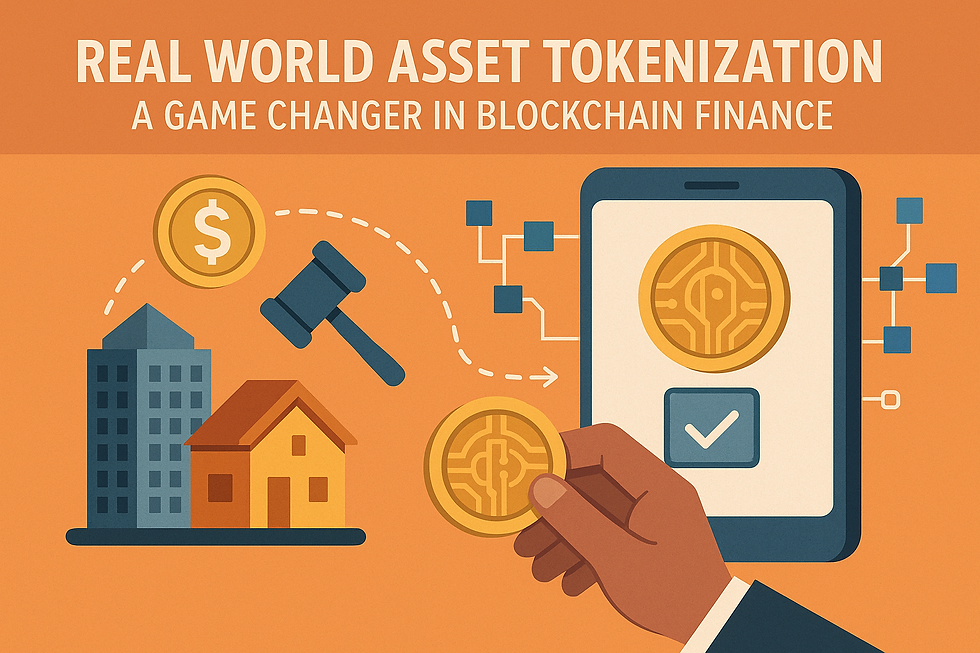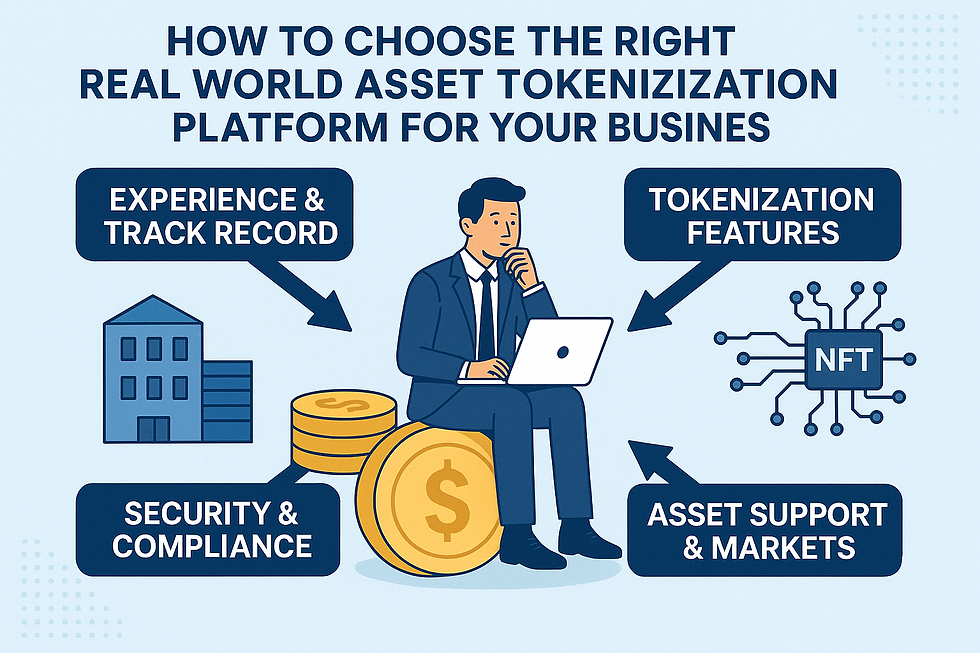Real World Asset Tokenization: A Game Changer in Blockchain Finance
- steveganger
- 6 days ago
- 4 min read

Introduction
The financial world is evolving faster than ever, and one of the most groundbreaking innovations driving this transformation is Real World Asset Tokenization. By bridging the gap between physical assets and blockchain technology, tokenization has introduced a new era of decentralized finance (DeFi) and digital investment. This paradigm shift is redefining ownership, liquidity, and accessibility in global markets, creating unprecedented opportunities for both institutional and retail investors.
What Is Real World Asset Tokenization?
The Concept of Tokenizing Real Assets
Real World Asset Tokenization is the process of converting tangible assets—like real estate, gold, or fine art—into digital tokens on a blockchain. Each token represents a fractional share of the underlying asset, making high-value investments accessible to a broader audience.
How Blockchain Enables Asset Tokenization
Blockchain acts as a trustless, immutable ledger, ensuring secure and transparent asset ownership. Smart contracts automate the processes of token issuance, distribution, and management, removing intermediaries and enhancing efficiency in financial transactions.
The Evolution of Blockchain Finance
From Cryptocurrencies to Tokenized Assets
Blockchain technology began with cryptocurrencies such as Bitcoin and Ethereum, but the next wave—tokenized assets—goes beyond currency. It applies blockchain’s trustless infrastructure to real-world investments, merging traditional finance with digital innovation.
The Role of DeFi in Modern Finance
Decentralized Finance (DeFi) expands blockchain’s potential by enabling permissionless lending, borrowing, and trading. When integrated with tokenized assets, DeFi transforms illiquid markets into dynamic, yield-generating ecosystems.
The Power of Real World Asset Tokenization
Bridging the Gap Between Traditional and Digital Finance
Tokenization connects conventional markets with blockchain-based systems, allowing investors to participate in asset classes previously out of reach. It merges regulated finance with the flexibility of digital ecosystems.
Enhancing Transparency and Security
Blockchain-based tokenization ensures every transaction and ownership record is publicly verifiable and immutable. This eliminates fraud and creates a transparent environment for global investors.
Unlocking Global Investment Opportunities
Tokenized assets can be traded globally without borders or intermediaries, granting investors from any region the ability to own a fraction of valuable assets and diversify their portfolios efficiently.
How Real World Asset Tokenization Works
Step 1: Asset Selection and Valuation
The process begins with identifying a suitable asset—real estate, intellectual property, or commodities—and conducting a professional valuation to establish its tokenized worth.
Step 2: Legal Structuring and Compliance
Regulatory frameworks are essential. Each asset is placed under a special purpose vehicle (SPV) to maintain legal clarity and investor protection.
Step 3: Token Creation and Distribution
Developers issue tokens representing asset shares. These tokens can follow standards like ERC-20 or ERC-1400, enabling interoperability across blockchain platforms.
Step 4: Secondary Market Trading
Once issued, tokens can be listed on regulated exchanges or RWA marketplaces, allowing investors to trade them freely and unlock liquidity.
Key Benefits of Real World Asset Tokenization
Liquidity Creation for Illiquid Assets
Traditionally illiquid assets such as real estate and collectibles become easily tradable through tokenization, giving investors the flexibility to enter or exit markets seamlessly.
Fractional Ownership and Accessibility
Tokenization democratizes investing by lowering entry barriers, allowing anyone to invest in multi-million-dollar assets for a fraction of the cost.
Cost-Efficient Transactions
By cutting out intermediaries like brokers or banks, blockchain-based tokenization drastically reduces transaction costs and settlement times.
Immutable Record Keeping
Each token transaction is recorded on the blockchain, ensuring auditability, transparency, and trust in every trade.
RWA Integration in Decentralized Finance (DeFi)
RWA Collateral in Lending and Borrowing Protocols
Tokenized RWAs are increasingly being used as collateral in DeFi lending platforms, enabling users to borrow stablecoins or other digital assets against real-world value.
Yield Generation and Liquidity Pools
By integrating RWAs into DeFi pools, investors can earn passive yields while maintaining exposure to real-world-backed assets—creating a bridge between physical and digital returns.
The Rise of Hybrid Financial Systems
The fusion of RWA integration with DeFi protocols marks the birth of hybrid finance, where digital securities coexist with traditional financial instruments.
The Role of Digital Securities in the RWA Ecosystem
Security Tokens vs. Utility Tokens
While utility tokens grant access to services, security tokens represent ownership rights and are backed by tangible assets—making them ideal for regulated tokenized investments.
Compliance Through Smart Contracts
Smart contracts ensure automatic enforcement of regulations, KYC checks, and transaction restrictions—ensuring that RWA tokenization remains legally compliant.
Institutional Adoption of Digital Securities
Financial institutions and asset managers are increasingly adopting digital securities to modernize asset management and attract tech-savvy investors.
Challenges in Real World Asset Tokenization
Regulatory and Legal Complexities
Regulation remains the biggest hurdle. Varying laws across countries create uncertainty in how tokenized assets are classified and traded.
Asset Valuation and Custody Risks
Ensuring accurate valuation and secure custody for physical assets requires trusted third parties and advanced security measures.
Market Education and Adoption Barriers
Many investors and businesses are still unfamiliar with tokenization’s benefits, slowing mainstream adoption.
Future of Real World Asset Tokenization
Global Acceptance and Policy Development
Governments and financial regulators are developing frameworks to legitimize tokenized assets, accelerating institutional participation and trust.
Integration with Central Bank Digital Currencies (CBDCs)
The integration of CBDCs and tokenized assets will create a seamless, regulated environment for cross-border payments and settlements.
Expansion of RWA-Backed DeFi Protocols
Future DeFi ecosystems will be powered by RWA-backed assets, creating sustainable and scalable financial models for global economies.
Conclusion
Real World Asset Tokenization stands as one of the most transformative innovations in blockchain finance. It combines the transparency of blockchain, the flexibility of DeFi, and the stability of real-world assets to reshape how value is created and exchanged. As RWA integration continues to expand across digital securities and decentralized ecosystems, the line between traditional and digital finance will blur—ushering in a new era of inclusive, efficient, and transparent investment opportunities.
FAQs
1. What is Real World Asset Tokenization?It’s the process of converting physical assets into blockchain-based tokens representing ownership or value.
2. How does RWA integration impact DeFi?It allows real assets like real estate and commodities to be used in DeFi lending and yield-generating protocols, enhancing liquidity.
3. Are tokenized assets regulated?Yes, depending on jurisdiction. Many countries are adopting frameworks for digital securities and blockchain-based investments.
4. What are the risks of tokenization?Risks include regulatory uncertainty, custody challenges, and market volatility.
5. Why is Real World Asset Tokenization important for the future?It’s revolutionizing finance by merging traditional investments with blockchain innovation, making markets more open and efficient.



Comments